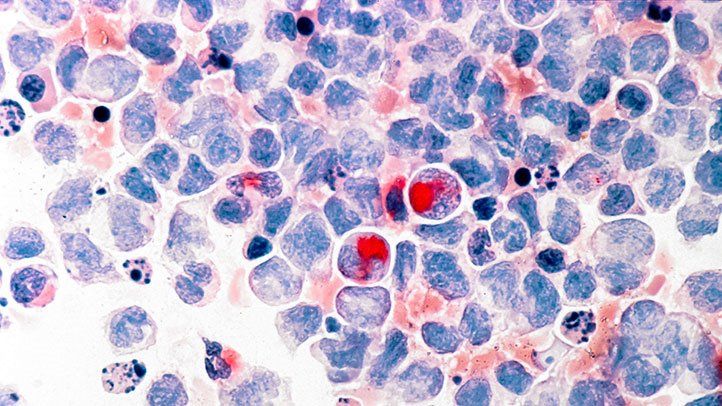- Chronic lymphocytic leukemia can be difficult to treat.
- According to researchers at Dana-Farber Cancer Institute, a new three-drug combination new three-drug combination, according to researchers at the Dana-Farber Cancer Institute, is showing promise in clinical trials.
- They are hoping that an ongoing phase 3 trial will provide enough evidence to get federal regulators to approve the new treatment.
Medical updates: A clinical research team led by Dana-Farber Cancer Institute reports that a combination of three molecularly targeted drugs is potent against chronic lymphocytic leukemia (CLL), a type of blood cell cancer that primarily affects older adults. The experimental triplet therapy, which included a second-generation inhibitor of BTK (acalabrutinib), an inhibitor of BCL-2(venetoclax), and a CD20 inhibitor (obinutuzumab), was tested on 37 patients with CLL who had not previously received treatment in a single-arm, phase 2 clinical trial. Throughout the course of the two-year study, 86 percent of trial participants demonstrated a significant response: no minimal residual disease (MRD) could be detected in these patients’ bone marrow using sensitive cellular tests, a key predictor of progression-free survival, according to the researchers in Lancet Oncology.
“This is the first published study to report on this three-drug combination for the treatment of CLL,” said first co-author Matthew Davids, MD, MMSc, Director of Clinical Research at Dana-Farber Cancer Institute’s Division of Lymphoma. We’ve found that the regimen not only shows remarkable activity against this form of cancer, but in this study, the rate of side effects is also quite low. These are very encouraging results.”
CLL treatment has progressed significantly in the last decade. The once-standard therapy, a cocktail of various traditional chemotherapy drugs, is no longer effective for patients with higher-risk forms of the disease and is often difficult for older patients to tolerate due to major side effects. Today, thanks to a slate of new, molecularly targeted drugs, this approach is rarely used.

These include the BCL-2 inhibitor venetoclax, which, when combined with another drug, the CD20 inhibitor obinutuzumab, can be an effective CLL treatment on its own. This two-drug regimen is already approved for CLL patients. BTK inhibitors are another important class of targeted agents. Acalabrutinib is a second-generation BTK inhibitor that has already been approved in CLL with or without obinutuzumab, and recent clinical studies indicate that it is better tolerated by CLL patients than the original BTK inhibitor, ibrutinib.
“These targeted drugs have sparked a revolution in CLL treatment,” said Davids. “But there is still room for improvement. Previous preclinical studies in our lab indicated that combining acalabrutinib and venetoclax together could have a meaningful impact for patients.”
Davids and his colleagues Benjamin Lampson, MD, PhD, and Jennifer Brown, MD, PhD, from Dana-Farber’s Center for CLL, launched a phase 2, single-arm clinical trial in 2018 with support from pharmaceutical company collaborators AstraZeneca and Genentech to evaluate acalabrutinib, venetoclax, and obinutuzumab (AVO) in patients with previously untreated CLL. The study included 37 patients, each of whom received at least one cycle of triplet combination therapy.
The drugs were administered in a series of 28-day cycles, starting with acalabrutinib in the first cycle. Venetoclax was added in cycle 4 and obinutuzumab in cycle 2. The majority of patients were treated for 15 or 24 months, depending on when they were found to have undetectable MRD in their bone marrow. MRD undetectability is increasingly recognized as the best predictor of future CLL disease progression.
Also read: https://medicalupdates.in/2022/11/10/developing-therapies-for-treatment-resistant-prostate-cancer/
The experimental triplet therapy is time-limited, which is an important feature. The goal is for patients to discontinue therapy once their disease has receded beyond detection, rather than continuing on it for many years.
When examined over the course of the study, 86 percent of participants had undetectable MRD in their bone marrow. Thirty-eight percent achieved the primary endpoint of undetectable MRD at the start of cycle 16 and complete remission. Moreover, the rate of significant side effects was low in comparison to a previous study that used ibrutinib instead of acalabrutinib in a similar triplet-based regimen.
Based on these results, Davids and his colleagues are enlisting a new group of patients in their study to test the efficacy of this AVO triplet therapy against high-risk forms of CLL, such as those with TP53 mutations or deletions. In addition, a phase 3 randomized trial is currently underway to compare the therapy to other treatment combinations. If the results of this larger study are positive, AVO could be approved as a new standard of care for CLL initial therapy.
“A time-limited treatment that is highly effective and well-tolerated by patients could be a significant advance for the field,” said Davids. “It’s exciting to think that we may be able to do better than the currently approved treatments, especially for older patients and those with high-risk disease.”

